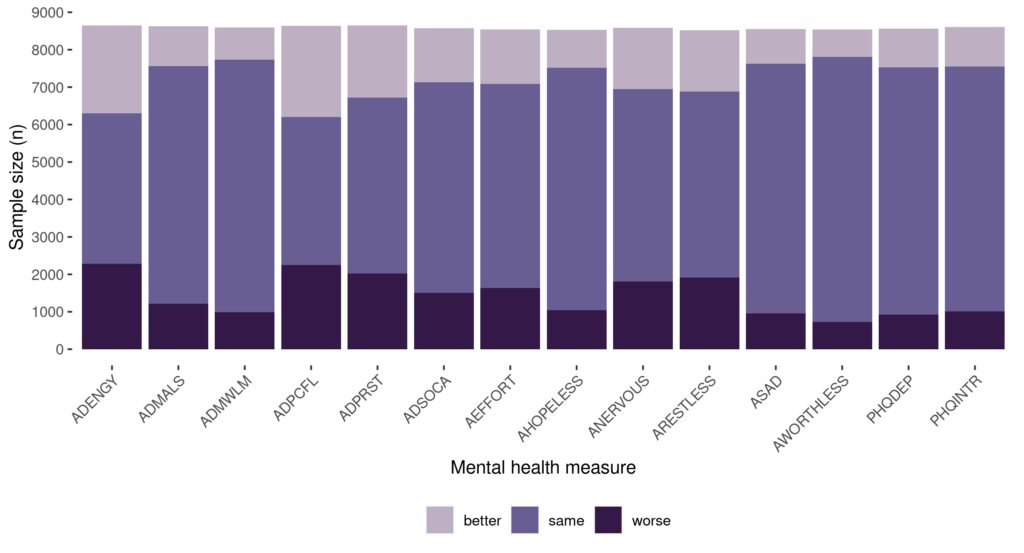By Julia A. Rivera Drew and Natalie Del Ponte
The Medical Expenditure Panel Survey-Household Component, or MEPS-HC, data are an invaluable resource for studying short-term trajectories in health, including adult mental health. An integrated series of the MEPS-HC data is available at IPUMS MEPS. Collected on the Self-Administered Questionnaire and, starting in 2019, the Preventive Self-Administered Questionnaire, the MEPS-HC includes two validated adult mental health scales. The Kessler Psychological Distress Scale (K6) and the two-item Patient Health Questionnaire depression screener (PHQ-2) are asked twice per panel, during interview rounds 2 and 4 (see Table 1). There are also two validated scales measuring health-related quality of life (HRQOL) that capture several interrelated health domains, including mental health. These include the Short Form-12 (SF-12) in 2000-2016 and the Veterans RAND-12 (VR-12) starting in 2017 (see Table 2 for VR-12 measures). For more information on the SF-12, see the section on SF-12 scoring on MCS and for more information on the VR-12, see ADDAYA.
Table 1. Validated Adult Mental Health Scales Available in the MEPS
| Mental Health Scale/ Question | Item Wording | Availability |
|---|---|---|
| Kessler Psychological Distress Scale (K6)1 | 2004-present | |
| AEFFORT | During the past 30 days, how often did you feel that everything was an effort? | |
| ASAD | During the past 30 days, how often did you feel so sad that nothing could cheer you up? | |
| ANERVOUS | During the past 30 days, how often did you feel nervous? | |
| ARESTLESS | During the past 30 days, how often did you feel restless or fidgety? | |
| AHOPELESS | During the past 30 days, how often did you feel hopeless? | |
| AWORTHLESS | During the past 30 days, how often did you feel worthless? | |
| The 2 item Patient Health Questionnaire Depression Screener (PHQ-2)2 | 2004-present | |
| PHQINTR | Over the last 2 weeks, how often have you been bothered by the following problems? Little interest or pleasure in doing things. | |
| PHQDEP | Over the last 2 weeks, how often have you been bothered by the following problems? Feeling down, depressed, or hopeless. | |
2 See the description tab on PHQ2 for guidance on how to score the PHQ2.
Table 2. Veterans RAND 12-Item Questionnaire Measuring HRQOL
| Variable | Variable Label |
|---|---|
| HEALTH | Health status |
| ADDAYA | Health now limits moderate activities |
| ADCLIM | Health now limits climbing several flights of stairs |
| ADPALS | Accomplished less because of physical health: past 4 weeks |
| ADPWLM | Limited in kind of work because of physical health: past 4 weeks |
| ADMALS | Accomplished less because of emotional problems: past 4 weeks |
| ADMWLM | Did work less carefully because of emotional problems: past 4 weeks |
| ADPAIN | Pain interfered with normal work: past 4 weeks |
| ADPCFL | How often felt calm/peaceful: past 4 weeks |
| ADENGY | How often had a lot of energy: past 4 weeks |
| ADPRST | How often felt downhearted/depressed: past 4 weeks |
| ADSOCA | Physical or emotional health interfered with social activities: past 4 weeks |
How Much Change In Mental Health Can We Observe?
Researchers may be interested in combining measures of adult mental health with other information available on the MEPS-HC to study topics such as the impacts of job loss, a major episode of medical care, or divorce on adult mental health. For the study of such questions, it is useful to get a sense of how much change in mental health occurs during the MEPS two-year panel. Below, we include a graph visualizing the number of cases in the MEPS-HC panel covering 2017-2018 where mental health became worse, stayed the same, or improved for those with two observations on individual mental health measures (see Figure 1). In this example, there are roughly 8,500 adults with two mental health measurements (see the note below Figure 1 for sample sizes for each specific measure). Researchers can easily increase sample size by requesting multiple years of data from IPUMS MEPS to create a dataset of multiple panels pooled together.
Difference in reported mental health measure, 2017-2018
All persons 18+ in 2017 and 2018 with a known response in both years

Notes and Resources
Additional measures of adult mental health collected on the MEPS-HC will be added to IPUMS MEPS over the next year. These additional measures include reported ICD-9 or ICD-10 codes associated with various mental health conditions and a general mental health status question asked at each interview. Watch IPUMS user emails for new additions to IPUMS MEPS!
Users new to the MEPS data should note that the MEPS-HC is fielded to a subsample of households responding to the previous year’s NHIS. By linking the two, using restricted linking keys available from AHRQ, analysts can create a dataset where respondents have 3 observations on the K6 over a three-year period. Please refer to our NHIS-MEPS comparability table to identify other measures available for both surveys available through IPUMS.
Below, we highlight several peer-reviewed publications that have used the MEPS-HC data to study mental health to familiarize users with possible applications of the data.
- C. Drake, S.H. Busch, & E Golberstein. The effects of federal parity on mental health services use and spending: Evidence from the Medical Expenditure Panel Survey. Psychiatric Services. (2019). https://doi.org/10.1176/appi.ps.201800313
- S.H. Rim, K.R. Yabroff, S. Dasari, et al. Preventive care service use among cancer survivors with serious psychological distress: An analysis of the medical expenditure panel survey data. Preventive Medicine. (2019)123:152-159. https://doi.org/10.1016/j.ypmed.2019.03.024
- C.H. Wu, C.C. Wang, A.J. Katz, et al. National trends of psychotropic medication use among patients diagnosed with anxiety disorders: Results from Medical Expenditure Panel Survey 2004-2009. Journal of Anxiety Disorders. (2013)27(2):163-170. https://doi.org/10.1016/j.janxdis.2012.11.004




